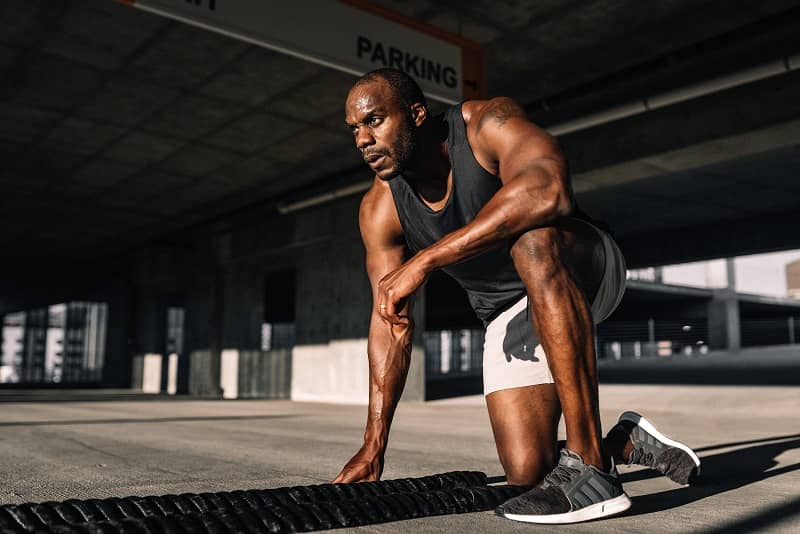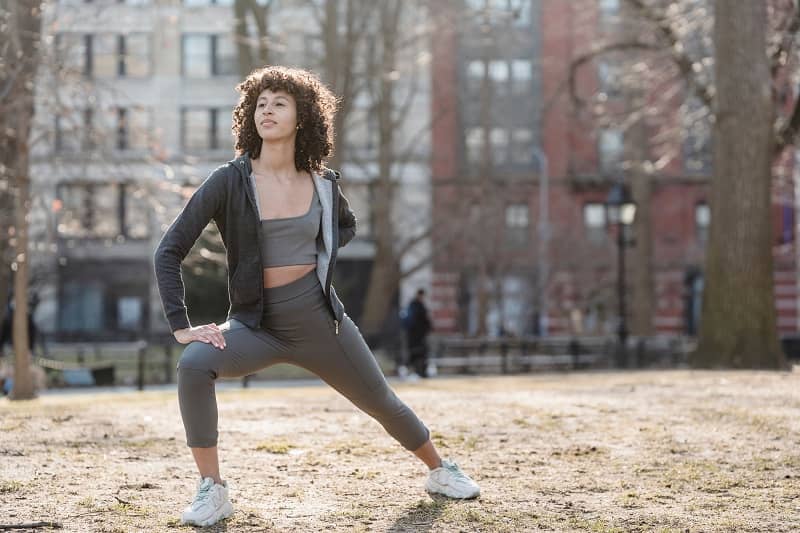“This is going to hurt the next day!!”
Muscle soreness post-workout is a common reward to intense training.
And although these muscles become stronger once your body relaxes, there is no doubt that these pains are slightly annoying.
DOMS (Delayed Onset Muscle Soreness) is a term that defines the muscular pain and stiffness that happens after an intense workout.
This usually peaks after 24-72 hours of strenuous workout.
Moreover, this is also a natural way for your body to show that it’s now time to slow down a bit.
But how to get rid of muscle soreness after workout?
Well, there are a dozen of ways to stop muscle soreness and we’ll be discussing it in detail further.
But before that, it’s vital to know when muscle soreness occurs.
When Do Muscle Soreness Occur?

Muscle soreness is pretty common.
And I’m sure you must have felt muscle stiffness after participating in strenuous physical activity.
It also happens when you resume working out after a few months or days.
According to experts, muscle soreness is a result of a small muscle fiber tear that happens after your workout.
These micro-muscle tears cause intense pain and inflammation which reaches its peak point within 72 hours.
According to scientists, these mild muscle fiber injury caused due to excessive stress when coupled with inflammation causes pain.
So, if that’s the case, “Should I workout with sore muscles?”
Of course yes!
But only when the muscle pain is a little less and bearable.
If in case you are experiencing extreme muscle soreness, you must stop working out and seek medical help right away.
And to understand that, here are some of the symptoms of extreme muscle soreness after the workout that’ll help you differentiate the type of muscle pain and find out how to get rid of workout soreness.
#1. Excruciating pain makes you unable to stand.
#2. Legs that are severely swollen.
#3. Due to excessive swelling, there is a loss of joint range of motion.
#4. Urine that is dark in hue or if you’re producing less urine.
Often, people ask, “I got sore muscles after a workout, should I continue?”
Due to muscle soreness, if you’re considering stopping your workout routine, make every effort to get through the first few days without becoming disheartened.
And if you are wondering how to get rid of soreness after a workout, then worry less.
Simply, use these twelve research-proven tactics.
12 Ways to Get Rid of Sore Muscles after Workout

The following 12 ways are best as sore muscles remedy.
#1. Eat Mushrooms
According to numerous sources, mushrooms offer anti-inflammatory qualities that may be beneficial in relieving some muscular discomfort.
Polysaccharides, which are anti-inflammatory chemicals found in mushrooms, serve to lower inflammation-causing cytokine molecules.
#2. Do an Active Cooldown
Spending some time cooling down prepares your muscles for recuperation.
The researchers believe it was due to increased blood flow, which decreased blood lactate (the metabolic byproduct that causes muscular pain).
In addition, a 2012 study discovered that those who conducted 20 minutes of low-to-moderate-intensity cycling immediately after their strength session had less muscle discomfort.
#3. Drink Some Tart Cherry Juice
Antioxidants and anti-inflammatory substances abound in tart cherry juice.
Long-distance runners who drank sour cherry juice for 8 days reported less muscle soreness, according to a 2010 study.
Cherry’s anti-inflammatory qualities, like mushrooms’, may be effective in reducing muscle discomfort.
However, in the case of tart cherry extract, one should be conscious of the high sugar level that may be present.
#4. Get a Massage
Massages can relieve painful muscles, which may seem obvious.
According to a 2012 study, a post-exercise massage considerably decreases pain by lowering the release of cytokines, which are molecules that promote inflammation in the body.
Massage, on the other hand, stimulates mitochondria in cells, boosting cell activity and repair.
Many people are in a hurry and seldom ask how to relieve sore muscles fast. So, a good massage is always a quick way to get rid of the soreness.
#5. Use a Heating Pad and Apply Ice Pack
Heating pads are supposed to drain some of the toxins or inflammation associated with muscular soreness out of the muscles since they are a vasodilator (opens up your blood vessels).
Putting an ice pack on your thighs could be the ideal solution. Following exercise-induced muscular soreness, alternating cold and heat may be most effective.
So, next time you’re wondering how to relieve sore muscles in thighs, try this method.
According to a 2015 study, utilizing both heat and ice is effective for acute musculoskeletal injury and DOMS. After exercising, switching from icing to warmth lessens muscle discomfort.
Applying ice for 20 minutes followed by heat for 20 minutes maybe a helpful strategy for addressing muscular soreness after exercise.
And if you want to know how to relieve sore muscles in legs, then try this in that case as well.
#6. Use Foam Roller
Foam rolling on aching muscles can make even grown men cry, yet it actually helps your muscles recover.
It has been proposed that foam rolling may reduce edema (muscle swelling) and improve tissue repair.
According to a 2015 study, 20 minutes of foam rolling on a high-density foam roller immediately following exercise and 24 hours later may lessen muscular discomfort and influence one’s dynamic motions.
#7. Take an Ice Bath
An ice bath, according to 2010 research, reduces swelling and tissue breakdown that causes DOMS by restricting blood vessels.
For 5 to 10 minutes, sit in an ice bath.
In a 2014 study, participants who took ice baths for 10 minutes after exercise reported the least amount of pain and muscular tightness when asked to stretch.
Overall, some claim that ice baths can lessen muscle discomfort by 20%.
#8. Wear Compression Gear
It’s not merely to show off all of your hard work.
According to a 2014 study, compression gear reduced muscle discomfort and accelerated muscle recovery by restricting your muscles and reducing fluid buildup post-workout while improving blood flow.
This aided in the removal of creatine kinase, an enzyme in your muscles that can cause discomfort.
#9. Get a Good Sleep
It may seem obvious, but a good night’s sleep is frequently just what your aching muscles require.
The direct scientific link between sleep and post-exercise recovery remains somewhat hazy.
It may be argued that this is due to the fact that sleep comprises a plethora of physiological activities that aren’t always possible to properly describe and separate.
We do know, however, that a lack of sleep can contribute to increased inflammation levels.
Inflammation may not be a cause for DOMS in particular, but it does contribute to certain muscular soreness, which can be alleviated with adequate rest.
#10. Eat Antioxidants and Protein Frequently in the Next 24 Hours
Your post-workout protein shake has a purpose that’s more than simply refueling your muscles.
A 2017 study discovered that protein benefited in the recovery of muscle function in the 24 hours following an eccentric contraction-heavy workout (which generally happens in most strength-based workouts).
And including antioxidants in breakfast aided recovery from those workouts even more.
So, in the hours following a strenuous workout, stock up on protein (think chicken or fish) and antioxidant-rich meals (think pomegranates and greens), and watch your recovery times shrink.
#11. Drink Coffee
Many people ask what to drink for sore muscles. The answer is coffee.
Caffeine use before a workout has been shown in multiple trials to lessen post-workout muscle pain and tiredness.
In one study published in the Journal of Pain, exercisers experienced a 48 percent reduction in DOMS.
Caffeine has analgesic (pain-killing) qualities aside from making things better, which is why it is widely found in over-the-counter pain treatments.
Drink two cups of coffee an hour before a particularly strenuous workout (the amount of caffeine used in the Journal of Pain study).
#12. Stretches for Sore Muscles After a Workout
Stretching is another great way to get rid of soreness.
Single leg hamstring stretch and groin stretch are the best exercises to remove soreness from your body after a workout.
For people who ask how to get rid of sore legs from squats, stretching is the best way for that.
These 12 ways are the absolute best ways on how to get rid of sore muscles after workout.
However, they may divert your mind from the pain by making your skin feel cold or hot.
We have probably answered all your questions but there are still some frequently asked questions that might trouble you. We have solved them as well below.
FAQs
Get all the answers to muscle soreness-related queries right below.
#1. Do muscles grow on rest days?
Rest, in particular, is necessary for muscular growth. Micro tears form in your muscle tissue as a result of exercising.
However, during rest, cells known as fibroblasts rebuild it. This promotes tissue healing and growth, which results in stronger muscles.
#2. Is 24 hours enough rest for muscles?
Usually, 24 to 48 hours rest between exercises for the same muscle area is sufficient. This helps avoid overtraining and achieves greater outcomes.
#3. Is it OK to exercise with sore muscles?
If you’re hurting after working out, mild recovery exercises like walking or swimming are usually safe. They may even be useful and aid in your recovery.
However, if you are feeling exhaustion or pain, it is critical that you rest.
#4. How long do Sore muscles last after exercise?
DOMS normally lasts three to five days. The pain, which can range from minor to severe, usually manifests itself one or two days following the workout.
#5. Do sore muscles burn fat?
Muscle is used when you work out. This aids in the development of muscle mass, because muscle tissue burns more calories even when at rest than body fat.
Now that we have discussed everything about how to relieve sore muscles after workout, it’s time to wind up.
Final Thoughts
Having said all this about how to get rid of sore muscles after workout, remember that excessive exercise can result in significant pain, exhaustion, and even damage.
So, allow enough time for your muscles to fully recuperate before resuming a strenuous workout.
At the end of the day, DOMS is a good thing, and it’s your body’s way of telling you to take it easy until you feel comfortable again.
Ignoring your body’s signals can lead to more harm than good.
Overtraining on a regular basis leads to declining results, plateaus, and injury, so pay attention to your body and what it’s telling you in plain, easy-to-understand terms.
Any training program’s ultimate goal is to achieve the best possible balance of work and recovery.
So, work hard but don’t push beyond a limit and give your body enough rest to recover before the next session.
And try the above-mentioned remedies. It will help you further in getting rid of the soreness.